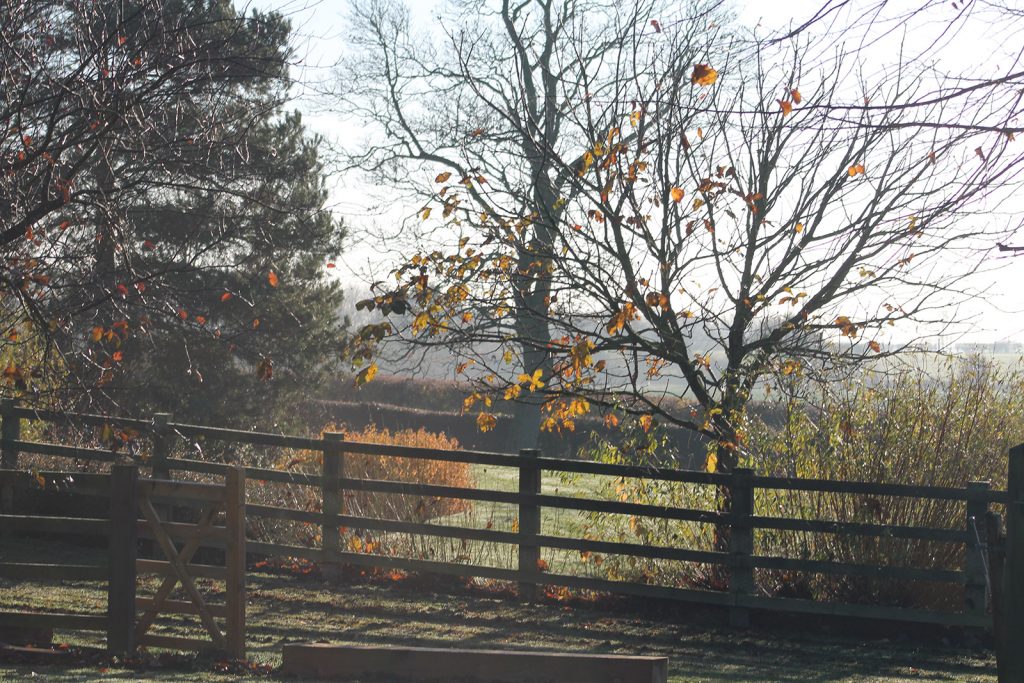
The concept
To create a garden of the 21st century – which has traditional elements of design but is innovative and aware of the environment and is experimental.
The location and site

Situated on a south west facing slope at 21 metres above sea level. The garden is situated on an exposed hillside site. The upper part of the garden is on sand which changes to clay at the foot of the slope.
There is very little shelter from the west, but the worst north winds are filtered by a shelter belt. The site is to the west of an 18th century barn and whilst preparing the new driveway we came across some very old stone foundations (which were reburied) which suggests a much earlier dwelling or building on the site. Could this be the site of the old Roman farmstead?
Background
In 2000 a dream became reality when The Garden House was built on the site of a former 1930s bungalow built by my great aunt Annie Winifred Neave, (a true character and enthusiastic cottage gardener) had it not been for her foresight in building here The Garden House would not have been built on such an outstanding site.
Chris Neave is the fourth generation to live at Saxby -educated at Culford School and at Writtle College where he gained an HND in Amenity Horticulture Landscape Design and Recreation he went on to run a successful commercial landscape business for 20 years before embarking on the development of Brightwater Gardens with his partner Jonathan Cartwright (also from a farming background). Chris and Jonathan are both passionate about gardening and the environment.
History
Saxby is a small village situated 10 miles north of Lincoln overlooking the upper Ancholme valley to the south and east and the Ermine Street to the west. Fragments of pottery and the discovery of a quern (a stone hand mill) are evidence that Saxby was occupied in Roman Times. Legend suggests a Roman villa at Saxby – a farmhouse is more likely.
The name ‘Sassebi’ in the Domesday Book shows that it was probably occupied by the Danish invaders in the ninth century. At the time of the Domesday Book of 1086 Saxby belonged to the King.
Saxby passed into the ownership of St. Katherine’s Priory, Lincoln during the eleventh or twelth century. St. Katherine’s Priory was a hospital for the poor and sick administered by Gilbertine canons and nuns. St. Katherines owned Saxby until the dissolution of the monasteries by Henry VIII in 1531.

Robert Saunderson bought land at Saxby on 20 May 1563 his son, Sir Nicholas Saunderson inherited the Saxby estate in 1582 and became 1st Viscount Castleton in 1627. James Saunderson the 5th Viscount and 1st Earl of Castleton died in 1723 and his estates passed to Thomas Lumley who assumed the Saunderson name and became the 3rd Earl of Scarbrough.
Richard, 4th Earl of Scarbrough was responsible for the rebuilding of the church in 1775 and the building of the Scarbrough family seat Sandbeck Hall near Tickhill. The church was the family mausoleum until the mid 19th century.
For four hundred and fifty years, Saxby has had close connections with the Saundersons and the Earls of Scarbrough. The estate was sold in 1917 to my great grandfather George Neave. However the connection continued until the death of the 12th Earl in 2004. He was the last Scarbrough patron of St. Helen’s Church and Lord of the Manor.
